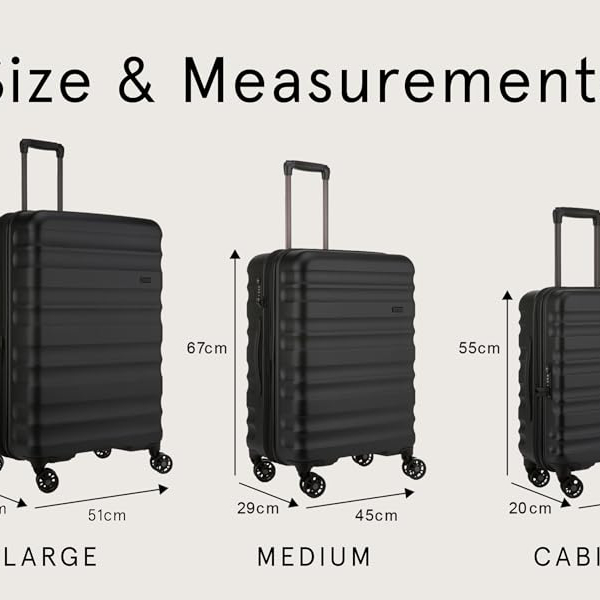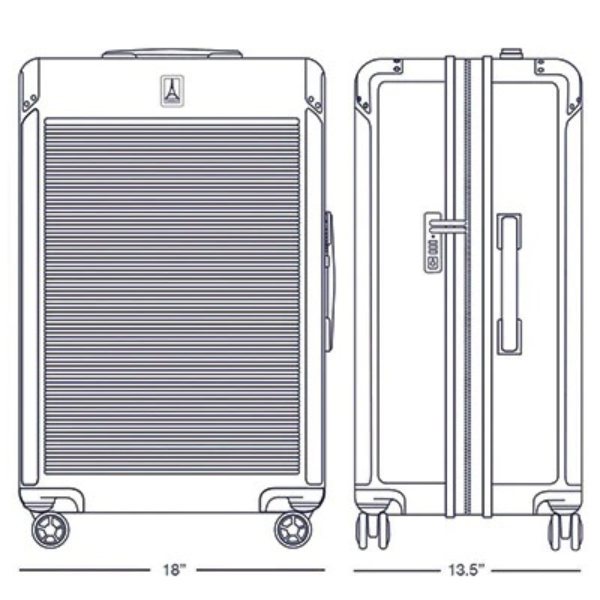An Introduction to Standard Suitcase Sizes
When preparing for a trip, choosing the right suitcase is key. This choice often hinges on understanding standard suitcase dimensions. So, what are these dimensions, and how do they match your travel needs? There isn’t a strict set of rules, but there are common sizes most travelers rely on.

These sizes provide guidance but may vary slightly by the brand. Suitcases fall into several categories: carry-on, small checked, large checked, and extra large. The size you pick should correspond to your trip duration and how much you intend to pack. Trip type, such as a beach vacation or ski holiday, can affect your choice as well.
A point to note: each airline has its own luggage size and weight restrictions. It’s important to check these before you fly. Keeping in mind the standard sizes can help you avoid extra fees and ensure your luggage fits in the overhead compartment or cargo space. Sizes are commonly marked as Small (S), Medium (M), Large (L) and Extra Large (XL). These labels represent a range of dimensions that accommodate different travel durations and packing styles, be it minimalistic or comprehensive.
Let’s delve deeper into the standard suitcase sizes, starting with the smallest, and understand their average use for your travels.
Determining Suitcase Size Based on Trip Duration
When planning your trip, the duration is a key factor in choosing your suitcase size. Considering how long you will be away helps dictate the amount of clothing and accessories you’ll need. Let’s explore the appropriate sizes for different trip lengths, beginning with a week-long holiday.
Week-long Beach Vacation: Which Size Fits Best?
For a week at the beach, a medium (M) suitcase typically suffices. These are suitable for travelers who pack light to moderate amounts. You can expect to fit in casual wear, swimwear, and some extras. The standard dimensions of an M-sized suitcase allow enough space for seven days’ worth of items. Always check with your airline for baggage allowances to avoid extra fees. For your week at the beach, consider a TSA lock suitcase to secure your medium-sized bag while accommodating your light to moderate packing needs.
One-week Ski Holiday: Is a Larger Suitcase Necessary?
If you’re heading to the slopes for a week, consider a large (L) suitcase. Winter gear like coats, boots, and ski equipment takes up more space. The L size offers that extra room for bulkier items. It ensures you have all your essentials without cramming your bag. Remember to weigh your suitcase to prevent overweight charges at the airport.

Common Suitcase Sizes Explained
Understanding different suitcase sizes can greatly enhance your travel experience.
Size S ? The Ideal Carry-on Suitcase
Size S suitcases, or carry-on bags, are optimal for short trips up to 3 days. They generally measure around 55x40x20 cm, fitting most airline overhead compartments. These bags are perfect for light travelers and can avoid checked baggage fees.
Size M ? Perfect for Small Checked Luggage
The medium suitcase is versatile for one-week trips. It’s considered small checked luggage, requiring check-in at airports. Size M generally accommodates trips where minimal to moderate packing is needed, such as a beach vacation lasting up to two weeks.
Size L ? Best for Extended Stays
When traveling for two weeks or more, a large suitcase (Size L) is ideal. It fits more items, necessary for longer stays or bulkier clothing like winter gear. Always check airline regulations, as these bags may need to comply with specific size restrictions.
Size XL ? When to Choose Extra Large Suitcases
The extra-large suitcase is suitable for extended trips of 2 to 3 weeks. However, size XL often exceeds standard airline dimensions for check-in luggage, potentially incurring extra fees. It’s essential to verify size allowances with your airline before traveling.
When flying, it’s crucial to know the airline’s luggage rules. Suitcases that are too big may cost extra. Airlines set limits on luggage size and weight. This stops oversized bags from filling the plane. Before packing, always check your airline’s limitations online. This way, you avoid surprise fees.
Understanding the 158 cm Rule for Checked Luggage
The 158 cm rule is about size, not weight. Airlines use this rule for checked bags. It means the total of length, width, and height must be under 158 cm. Go over, and you might have to pay more, or worse, they won’t take your bag. This rule helps airlines manage space.
How to Measure Your Suitcase to Comply with Airline Regulations
To avoid issues, measure your suitcase before you fly. Include the wheels and handles in your size check. Here’s how: Measure the length, width, and depth of your bag. Add them up. If it’s 158 cm or less, you’re good. If it’s more, consider a smaller suitcase. Knowing these details keeps travel smooth. Check the bag size every time, as airlines can change their rules. Ensure your Spiderman suitcase for kids meets airline dimensions to avoid travel hassles and keep your journey fun and smooth!

Selecting the Right Suitcase Volume
Choosing a suitcase with the correct volume is essential for managing your luggage weight and avoiding fees.
Choosing the Right Size Suitcase
When planning travel with a 23 kg luggage limit, selecting the perfect suitcase is crucial. Size M works well for lighter belongings, allowing travelers to pack efficiently. However, if you have heavier gear, Size L is the better choice. Additionally, the weight limits may differ between airlines, so travelers should verify the restrictions beforehand. This ensures travelers avoid extra fees and unpleasant surprises at the airport. Ultimately, understanding the suitcase sizes can help streamline packing and enhance travel experiences.
Packing Tips for a 1-Week Trip
A 1-week trip typically requires a Size M suitcase for efficiency. It provides ample space for daily outfits, toiletries, and a few additional items. If the destination features cooler weather, travelers might need bulkier clothing. In such cases, choosing Size L ensures adequate packing without exceeding weight limits. Moreover, prioritizing essential items and versatile clothing can help make the best use of space. Roll clothes to maximize room and minimize wrinkles, while utilizing packing cubes for organization. Overall, packing strategically allows travelers to enjoy their trip with less hassle.
Best Choice of Suitcase for 2-week Trips
For 2-week ventures, Size L is your best bet. It can hold the increased load, especially if you’re packing for varied weather or occasions. Check your airline’s size rules to dodge extra charges.
FAQs on Suitcase Sizes and Air Travel
Travelers often have many questions about suitcase sizes and airline regulations. Below are some frequently asked questions that will help you travel smarter and more efficiently. Understanding the standard suitcase dimensions can help you avoid fees and ensure a smooth travel experience.
Airline Standards for Carry-On Luggage
Each airline sets their own limits for carry-on luggage size. However, there’s a general size that many airlines accept: about 55x40x20 cm. It’s important to check with your specific airline before travel. This ensures your carry-on fits in the overhead bin without issues. When packing your suitcase, knowing how to fold your suit efficiently can help maximize space while ensuring your carry-on meets airline size restrictions.
Is Carry-On Sufficient for a 2-Week Trip?
Usually, a carry-on is for trips of 3 to 5 days. For a 2-week trip, most people need more space. However, if you pack light or have laundry options at your destination, a carry-on might just work. It depends on your packing style and the nature of your trip. For a 2-week trip, consider the standard suitcase dimensions to ensure you have enough space if a carry-on isn’t sufficient for your needs.
Maximum Weight Allowance for Airline Luggage
The weight limit for checked luggage varies by airline and ticket type. Commonly, the max weight is about 20 to 23 kg for standard fares. Some airlines allow up to 32 kg for higher-priced tickets. Always check your airline’s weight policies to avoid extra charges for heavy bags. When traveling, be mindful of not only the weight limit but also the standard suitcase dimensions to ensure your luggage complies with your airline’s policy.